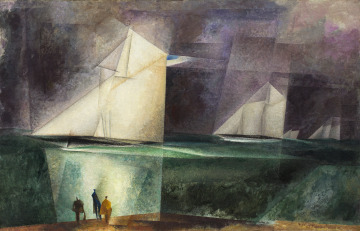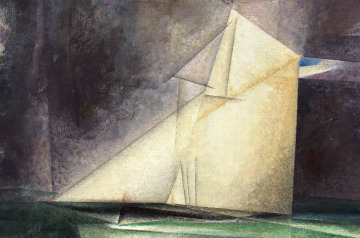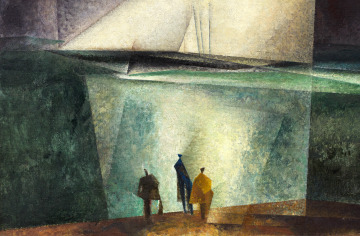The Glorious Victory of the Sloop “Maria”
- Date
- 1926
- Material
- Oil on canvas
- made in
- Dessau, Sachsen-Anhalt state, Germany, Europe
- depicts
- New York, New York, United States, North and Central America
- Classification
- Paintings
- Collection
- American Art
- Current Location
- On View, Gallery 235
- Dimensions
- 21 7/8 x 33 1/2 in. (55.6 x 85.1 cm)
framed: 25 in. x 36 7/8 in. x 2 1/2 in. (63.5 x 93.7 x 6.4 cm) - Credit Line
- Eliza McMillan Trust
- Rights
- Public Domain
- Object Number
- 848:1940
Provenance
1926 - October 11, 1937
Stadtmuseum, Dresden, Germany [1]
October 11, 1937 - December 18, 1939
German National Socialist (Nazi) government, confiscated as "degenerate" from the Stadtmuseum, Dresden [2]
December 18, 1939 - 1940
Buch- und Kunsthandlung Karl Buchholz, Berlin [3]
1940 - 1940
Buchholz Gallery (Curt Valentin), New York, NY, USA [4]
1940 -
Saint Louis Art Museum, purchased from Buchholz Gallery [5]
Notes:
[1] This painting was purchased by the City of Dresden from the International Exhibition in Dresden in 1926 ["Internationale Kunst Ausstellung Dresden." Dresden, Germany, June-September, 1926, cat. 475]. It was almost immediately lent to the State Art Collection's Gemäldegalerie, Dresden in January 1927, and was included in their 1930 Gallery Catalogue ["Die Staatliche Gemäldegalerie zu Dresden: Katalog der Modernen Galerie." Dresden: W. und B. V. Baensch, 1930, cat. 2615]. The painting remained at the Gemäldegalerie until September 1933, when the Nazis came to power, and the Gemäldegalerie had to clear its exhibition spaces of modern art, at which time it was returned to the city-owned Stadtmuseum (now known as the Städtische Galerie Dresden) [letters dated August 10, 2004 and August 13, 2004 from Johannes Schmidt, curator at the Städtische Galerie Dresden, SLAM document files].
The seizure date of October 11, 1937, is identified in a letter from Karl Buchholz to the Propaganda Ministry of March 4, 1939. Karl Buchholz, letter to Propaganda Ministry, Händlerakte Buchholz, Bundesarchiv Berlin, R55/21017, Bl. 90. Source cited by Beschlagnahmeinventar "Entartete Kunst", "Degenerate Art" Research Center, FU Berlin.
[2] The painting was seized from the Stadtmuseum, Dresden in August 1937 as part of the National Socialist campaign against so-called degenerate art, and assigned Reichskulturkammer number 13380 [letters dated August 12, 2004 and August 17, 2004 from Johannes Schmidt, SLAM document files]. Two works by Feininger are listed as confiscated from the Staatliche Kunstsammlungen, Dresden in the list of Nazi confiscations published in 1962, although no titles are given [Roh, Franz. "Entartete Kunst: Kunstbarbarei im Dritten Reich." Hannover: Fackelträger-Verlag, 1962, p. 149].
[3] The paintined was purchased by Karl Buchholz for $100 on December 18, 1939. Source: Franz Hofmann, letter to Karl Buchholz, December 18, 1939, Händlerakte Buchholz, Bundesarchiv, Berlin, R 55/21017. Source cited by Beschlagnahmeinventar "Entartete Kunst", "Degenerate Art" Research Center, FU Berlin.
[4] According to Hans Hess, Curt Valentin was able to 'rescue' some of Feininger's paintings that had been removed from German museums, and exhibit them in his gallery [Hess, Hans. "Lyonel Feininger." New York: Harry N. Abrams, Inc., 1961, p. 146]. This painting was included in an exhibition at Curt Valentin's Buchholz Gallery in April 1940 ["Landmarks in Modern German Art." New York: Buchholz Gallery (Curt Valentin), April 2-27, 1940, cat. 4]. The invoice from Buchholz Gallery dated October 8, 1940, mistakenly indicates that the painting was formerly in the collection of Kaiser Friedrich Museum, Magdeburg, Germany [SLAM document files].
[5] Minutes of the Administrative Board of Control of the City Art Museum, October 3, 1940.
Stadtmuseum, Dresden, Germany [1]
October 11, 1937 - December 18, 1939
German National Socialist (Nazi) government, confiscated as "degenerate" from the Stadtmuseum, Dresden [2]
December 18, 1939 - 1940
Buch- und Kunsthandlung Karl Buchholz, Berlin [3]
1940 - 1940
Buchholz Gallery (Curt Valentin), New York, NY, USA [4]
1940 -
Saint Louis Art Museum, purchased from Buchholz Gallery [5]
Notes:
[1] This painting was purchased by the City of Dresden from the International Exhibition in Dresden in 1926 ["Internationale Kunst Ausstellung Dresden." Dresden, Germany, June-September, 1926, cat. 475]. It was almost immediately lent to the State Art Collection's Gemäldegalerie, Dresden in January 1927, and was included in their 1930 Gallery Catalogue ["Die Staatliche Gemäldegalerie zu Dresden: Katalog der Modernen Galerie." Dresden: W. und B. V. Baensch, 1930, cat. 2615]. The painting remained at the Gemäldegalerie until September 1933, when the Nazis came to power, and the Gemäldegalerie had to clear its exhibition spaces of modern art, at which time it was returned to the city-owned Stadtmuseum (now known as the Städtische Galerie Dresden) [letters dated August 10, 2004 and August 13, 2004 from Johannes Schmidt, curator at the Städtische Galerie Dresden, SLAM document files].
The seizure date of October 11, 1937, is identified in a letter from Karl Buchholz to the Propaganda Ministry of March 4, 1939. Karl Buchholz, letter to Propaganda Ministry, Händlerakte Buchholz, Bundesarchiv Berlin, R55/21017, Bl. 90. Source cited by Beschlagnahmeinventar "Entartete Kunst", "Degenerate Art" Research Center, FU Berlin.
[2] The painting was seized from the Stadtmuseum, Dresden in August 1937 as part of the National Socialist campaign against so-called degenerate art, and assigned Reichskulturkammer number 13380 [letters dated August 12, 2004 and August 17, 2004 from Johannes Schmidt, SLAM document files]. Two works by Feininger are listed as confiscated from the Staatliche Kunstsammlungen, Dresden in the list of Nazi confiscations published in 1962, although no titles are given [Roh, Franz. "Entartete Kunst: Kunstbarbarei im Dritten Reich." Hannover: Fackelträger-Verlag, 1962, p. 149].
[3] The paintined was purchased by Karl Buchholz for $100 on December 18, 1939. Source: Franz Hofmann, letter to Karl Buchholz, December 18, 1939, Händlerakte Buchholz, Bundesarchiv, Berlin, R 55/21017. Source cited by Beschlagnahmeinventar "Entartete Kunst", "Degenerate Art" Research Center, FU Berlin.
[4] According to Hans Hess, Curt Valentin was able to 'rescue' some of Feininger's paintings that had been removed from German museums, and exhibit them in his gallery [Hess, Hans. "Lyonel Feininger." New York: Harry N. Abrams, Inc., 1961, p. 146]. This painting was included in an exhibition at Curt Valentin's Buchholz Gallery in April 1940 ["Landmarks in Modern German Art." New York: Buchholz Gallery (Curt Valentin), April 2-27, 1940, cat. 4]. The invoice from Buchholz Gallery dated October 8, 1940, mistakenly indicates that the painting was formerly in the collection of Kaiser Friedrich Museum, Magdeburg, Germany [SLAM document files].
[5] Minutes of the Administrative Board of Control of the City Art Museum, October 3, 1940.
We regularly update records, which may be incomplete. If you have additional information, please contact us at provenance@slam.org.


